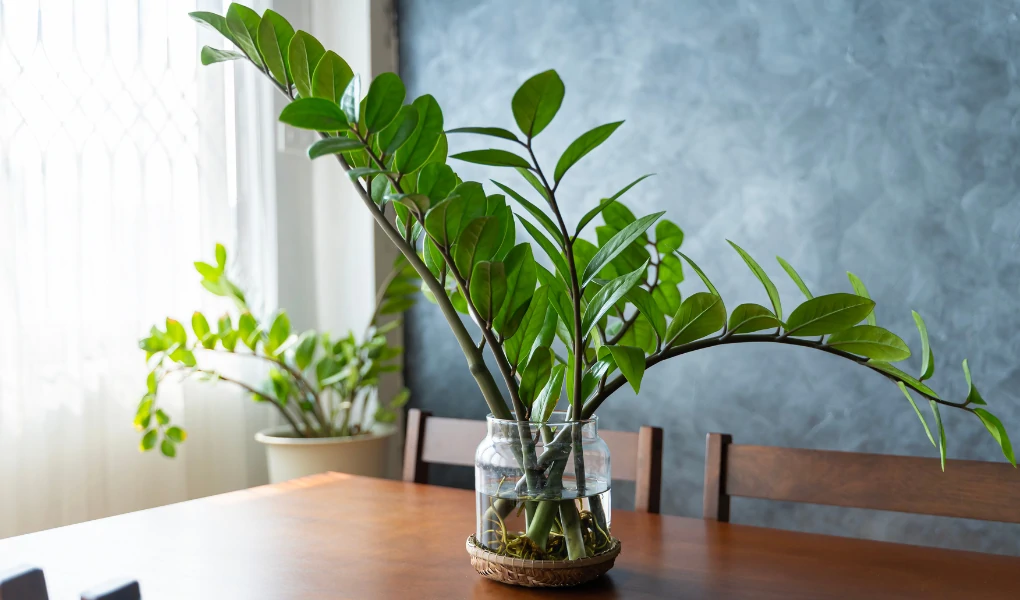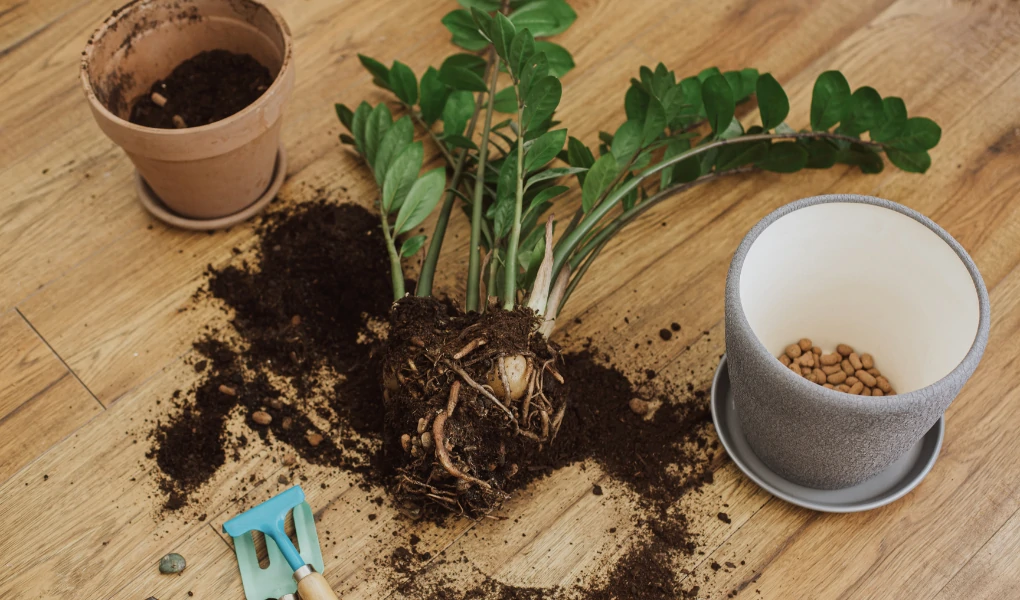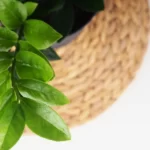Welcome to the world of indoor gardening!
If you’re a plant enthusiast seeking to enhance the beauty and elegance of your home or office space, then the Chameleon ZZ Plant is the perfect choice for you. With its stunning foliage, low maintenance requirements, and unique characteristics, this plant is truly a marvel. In this article, we will delve into the captivating world of the Chameleon ZZ Plant, exploring its origins, care tips, and the many reasons why it’s a must-have addition to your indoor garden.
Chameleon ZZ Plant: A Masterpiece of Nature
The Chameleon ZZ Plant (Zamioculcas zamiifolia) is a captivating species that originates from East Africa and is a variety of ZZ Plants. It belongs to the Araceae family and is known for its glossy, dark green leaves that grow in a fascinating feather-like pattern. The leaves are further enhanced by their contrasting veins, which can range from vibrant lime green to stunning golden hues. This unique color variation gives the plant its distinctive “chameleon” name, as its appearance can change depending on environmental conditions.
Unveiling the Beauty: How to Care for Your Chameleon ZZ Plant
1. Choosing the Right Location

Light: When it comes to the Chameleon ZZ Plant, choosing the right location is crucial for its growth and overall well-being. Here’s a detailed explanation of what you need to consider when selecting the ideal spot for your plant.
The Chameleon ZZ Plant thrives in bright, indirect light. It loves to bask in the gentle rays of the sun without being directly exposed to it. Place your plant near a window that receives filtered sunlight throughout the day. This allows the plant to benefit from the natural light while avoiding the intensity that can scorch its leaves.
If you don’t have a window that provides sufficient light, don’t worry! The Chameleon ZZ Plant is known for its ability to tolerate low-light conditions. You can place it in areas with minimal natural light, such as offices or rooms with limited sunlight. However, keep in mind that the plant may not grow as vigorously in low-light environments compared to brighter locations.
To ensure the best growth and health for your Chameleon ZZ Plant, you can also consider providing artificial grow lights. LED grow lights are a popular choice as they emit the right spectrum of light for plant growth. Position the lights above the plant, maintaining a distance of around 12 to 18 inches to prevent heat damage.
Remember, the key is to strike a balance between providing enough light and avoiding direct sunlight. Observing your plant’s response to its current location will also give you valuable insights. If you notice that the leaves are stretching toward the light source or becoming pale, it’s an indication that the plant needs more light. On the other hand, if the leaves start turning yellow or brown, it could be a sign of too much direct sunlight.
By considering these factors and finding the perfect spot with the right amount of light, you’ll create an optimal environment for your Chameleon ZZ Plant to thrive and showcase its stunning foliage.
You can also check our other care guides.
Hurricane Fern Care: A Comprehensive Guide
Umbrella Plants Care: Tips and Tricks for Thriving Greenery!
2. Optimal Temperature and Humidity

Creating the right temperature and humidity conditions is essential for the health and well-being of your Chameleon ZZ Plant. Let’s explore in detail what temperature range and humidity levels are optimal for this plant.
The Chameleon ZZ Plant is a resilient species that can adapt to a range of temperatures, but it thrives best within a specific range. Ideally, the temperature should be maintained between 65°F and 75°F (18°C to 24°C) for optimal growth. This temperature range mimics the comfortable conditions found in most indoor environments and allows the plant to flourish.
While the Chameleon ZZ Plant can tolerate slightly higher or lower temperatures for short periods, it’s important to avoid exposing it to extreme temperature fluctuations. Extreme cold can be particularly harmful to the plant, so make sure to keep it away from drafty areas or locations with significant temperature variations.
Humidity levels also play a role in the overall health of the Chameleon ZZ Plant. Fortunately, this plant can adapt to average humidity levels typically found in most homes. It doesn’t require high humidity like some tropical plants. However, if your indoor environment is excessively dry, you can take some measures to increase the humidity around your plant.
Here are a few tips to help you maintain optimal humidity levels for your Chameleon ZZ Plant:
- Grouping: Place your Chameleon ZZ Plant near other indoor plants. As plants release moisture through transpiration, grouping them together can create a microclimate with slightly higher humidity.
- Pebble Tray: Set up a pebble tray filled with water beneath the plant. As the water evaporates, it increases the humidity in the immediate vicinity of the plant. Make sure the water level is below the surface of the pebbles to prevent the plant from sitting in water.
- Misting: Lightly mist the leaves of your Chameleon ZZ Plant with room temperature water. This can provide temporary relief by increasing humidity levels around the plant. Avoid misting excessively, as it can lead to fungal issues.
- Room Humidifier: If you live in an arid climate or struggle to maintain adequate humidity levels, using a room humidifier can be beneficial. Set it to a level that suits both your plant’s needs and your comfort.
By ensuring the temperature stays within the recommended range and taking steps to maintain reasonable humidity levels, you’ll provide your Chameleon ZZ Plant with a favorable environment for growth and vitality. Regularly monitor the temperature and humidity conditions, and make adjustments as needed to keep your plant happy and healthy.
3. Watering: Striking the Right Balance

Watering your Chameleon ZZ Plant is a delicate balance that requires attention and careful consideration. Proper watering practices are essential for the plant’s health and to prevent issues like root rot or dehydration. Let’s dive into the details of striking the right balance when it comes to watering your Chameleon ZZ Plant.
The Chameleon ZZ Plant has a unique characteristic that sets it apart from many other houseplants—it can store water in its rhizomes. This adaptation allows the plant to survive drought conditions in its natural habitat. However, it’s important not to overwater or underwater the plant, as both can have adverse effects on its well-being.
To strike the right balance, follow these watering guidelines:
- Monitor the Soil: Before watering, check the moisture level of the soil. Insert your finger about an inch into the soil and feel for dampness. The top inch of the soil should be dry to the touch before you water again. If it still feels moist, wait a bit longer.
- Water Thoroughly: When it’s time to water, do so thoroughly. Use room temperature water and pour it evenly across the soil surface until it starts to flow out of the drainage holes. This ensures that water reaches the deeper roots and encourages healthy growth.
- Allow Proper Drainage: Adequate drainage is crucial for the Chameleon ZZ Plant. Ensure that the pot has drainage holes to allow excess water to escape. Standing water can lead to root rot and other water-related issues. Empty the saucer or tray beneath the pot after watering to prevent the plant from sitting in water.
- Avoid Overwatering: Overwatering is one of the most common mistakes made with the Chameleon ZZ Plant. It’s important to let the soil dry out partially between waterings. Waterlogged soil can suffocate the roots and lead to root rot. Signs of overwatering include yellowing leaves, wilting, and a foul odor.
- Don’t Underwater: While the Chameleon ZZ Plant can tolerate drought conditions, consistently underwatering it can cause stress and lead to leaf wilting and browning. It’s crucial to strike a balance and not let the plant become completely dehydrated. Remember to water thoroughly when the soil has dried out appropriately.
- Consider Environmental Factors: Factors like temperature, humidity, and the size of the pot can influence the watering frequency. Higher temperatures and lower humidity levels may require more frequent watering, while cooler temperatures and higher humidity levels may reduce the watering needs. Additionally, smaller pots tend to dry out faster than larger ones.
By monitoring the soil moisture, watering thoroughly, and allowing proper drainage, you’ll be able to strike the right balance when watering your Chameleon ZZ Plant. Pay attention to the plant’s response and adjust your watering schedule accordingly to ensure optimal health and growth.
4. Well-Draining Soil

Using well-draining soil is essential for the health and vitality of your Chameleon ZZ Plant. Well-draining soil allows excess water to flow through and prevents waterlogging, which can lead to root rot and other issues. Let’s delve into the importance of well-draining soil and how to achieve it for your plant.
Well-draining soil consists of a mixture that allows water to pass through easily, preventing it from pooling around the roots. It strikes a balance between retaining enough moisture for the plant’s needs and allowing excess water to drain away. Here are some factors to consider when creating or selecting well-draining soil for your Chameleon ZZ Plant:
- Components: A good mix for well-draining soil typically includes a combination of organic matter, inorganic materials, and a balanced potting mix. A common recipe includes a mix of peat moss, perlite, and regular potting soil. The peat moss helps retain moisture, while perlite provides excellent drainage. The potting soil adds nutrients and stability to the mixture.
- Peat Moss: Peat moss is a valuable component for retaining moisture in the soil. It has excellent water-holding capacity and aids in preventing the soil from drying out too quickly. Incorporating peat moss in the soil mixture improves water retention while still allowing excess water to drain away.
- Perlite: Perlite is a lightweight, volcanic glass material that is commonly used in potting mixes. Its porous structure promotes airflow and drainage, preventing the soil from becoming compacted. Adding perlite to the soil mixture increases aeration and ensures efficient water drainage, reducing the risk of waterlogged soil.
- Potting Soil: A balanced potting soil serves as a foundation for the well-draining mixture. It provides essential nutrients and support for the plant’s growth. Choose quality potting soil that is suitable for indoor plants, ensuring it is free from pests, diseases, and weed seeds.
To create well-draining soil for your Chameleon ZZ Plant, follow these steps:
- Start with a clean pot: Select a pot with drainage holes to allow excess water to escape.
- Prepare the soil mixture: In a container or bucket, mix equal parts peat moss, perlite, and potting soil. Adjust the ratios as needed to achieve a balance between water retention and drainage.
- Fill the pot: Add the well-draining soil mixture to the pot, leaving enough space for the plant’s root ball.
- Plant your Chameleon ZZ Plant: Gently remove the plant from its current pot, loosen the roots, and place it in the prepared pot. Ensure the plant is positioned at the same depth it was in its previous pot.
- Backfill with soil: Fill the remaining space around the roots with the well-draining soil mixture. Gently press the soil to secure the plant, avoiding excessive compaction.
Remember to avoid using heavy garden soil or soil mixes that are not specifically designed for indoor plants, as they may retain too much water and hinder proper drainage.
By using a well-draining soil mixture that includes peat moss, perlite, and potting soil, you provide the Chameleon ZZ Plant with the ideal growing medium. This ensures that water flows through the soil easily, preventing waterlogging and allowing the roots to breathe. Your Chameleon ZZ Plant will thrive in this optimal environment, promoting healthy growth and overall well-being.
5. Fertilizing: Nourishing Your Chameleon ZZ Plant

Fertilizing your Chameleon ZZ Plant is an important aspect of its care routine. While this plant is known for its ability to thrive with minimal fertilization, providing it with the necessary nutrients can promote healthy growth and vibrant foliage. Let’s explore the key considerations when it comes to fertilizing your Chameleon ZZ Plant.
- Choosing the Right Fertilizer: Selecting a balanced, water-soluble fertilizer is ideal for the Chameleon ZZ Plant. Look for a fertilizer with a ratio of equal parts nitrogen (N), phosphorus (P), and potassium (K), represented as NPK on the packaging. A balanced fertilizer, such as 10-10-10 or 20-20-20, provides a well-rounded mix of nutrients.
- Frequency: During the growing season, which typically spans from spring to summer, fertilize your Chameleon ZZ Plant every two to three months. This periodic fertilization provides a boost of nutrients to support its growth and development.
- Dilution and Application: Follow the instructions on the fertilizer packaging for dilution ratios. Generally, you’ll need to dilute the fertilizer in water before application. Use a watering can or sprayer to apply the diluted fertilizer to the soil around the base of the plant. Avoid direct contact with the leaves, as this can cause burning or damage.
- Avoid Over-Fertilization: It’s important not to over-fertilize your Chameleon ZZ Plant. Excessive amounts of fertilizer can lead to a build-up of salts in the soil, causing leaf burn and negatively impacting the plant’s health. Always follow the recommended dosage on the fertilizer packaging and err on the side of caution if unsure.
- Flush the Soil: To prevent salt build-up, it’s beneficial to flush the soil periodically. This involves thoroughly watering the plant to allow excess salts to leach out of the soil. This can be done every six months or if you notice signs of fertilizer accumulation, such as crusty residue on the soil surface.
- Organic Alternatives: If you prefer organic options, you can use organic fertilizers or natural alternatives like compost tea. Organic fertilizers release nutrients slowly and promote soil health. Compost tea can be made by steeping compost in water and using the nutrient-rich liquid to fertilize the plant.
Remember, while fertilizing is important, it’s equally crucial not to overdo it. The Chameleon ZZ Plant is known for its ability to thrive in nutrient-limited conditions, so a light feeding regimen is sufficient. Always monitor the plant’s response to fertilization and adjust the frequency and dosage as needed.
By providing your Chameleon ZZ Plant with a balanced fertilizer during the growing season and practicing moderation, you’ll supply the necessary nutrients for healthy growth and ensure the long-term vitality of your plant.
6. Repotting: Encouraging Healthy Growth

Repotting your Chameleon ZZ Plant is an essential part of its care routine and plays a significant role in encouraging healthy growth. Repotting allows the plant to access fresh nutrients, provides ample space for root development, and ensures optimal conditions for continued flourishing. Let’s explore the key aspects of repotting your Chameleon ZZ Plant.
- Timing: Repotting is typically done every two to three years, or when the plant has outgrown its current pot. Spring is an ideal time for repotting, as it aligns with the plant’s active growing season.
- Selecting the Right Pot: Choose a pot that is one size larger than the current one. The new pot should have drainage holes to prevent waterlogging. Selecting a pot with a wider base and slightly deeper height will allow the Chameleon ZZ Plant’s roots to spread and grow comfortably.
- Preparation: Before repotting, water the plant thoroughly. This helps to hydrate the roots and ease the removal from the old pot.
- Gently Removing the Plant: Carefully remove the Chameleon ZZ Plant from its current pot. Gently tap the sides of the pot or use a trowel to loosen the soil around the edges. Support the base of the plant with your hand and carefully lift it out, being mindful not to damage the roots.
- Inspecting and Trimming: Inspect the roots for any signs of rot, disease, or overcrowding. If you notice any unhealthy or damaged roots, trim them using clean, sharp scissors or pruning shears. Trimming encourages healthy root growth and prevents potential issues.
- Adding Fresh Soil: Place a layer of fresh, well-draining soil at the bottom of the new pot. Position the Chameleon ZZ Plant in the center, making sure it sits at the same depth as it was in the previous pot. Add more soil around the roots, gently pressing it down to secure the plant.
- Watering and Settling: After repotting, water the plant thoroughly to help settle the soil and provide hydration to the roots. Allow any excess water to drain out from the bottom of the pot before returning it to its desired location.
- Post-Repotting Care: Place the repotted Chameleon ZZ Plant in a location with appropriate lighting conditions and continue regular care, including monitoring soil moisture, maintaining optimal temperature and humidity, and providing the necessary water and nutrients.
Repotting provides the Chameleon ZZ Plant with fresh soil, ample root space, and renewed access to nutrients, promoting healthy growth and preventing the plant from becoming root-bound. Remember to observe the plant’s response after repotting and adjust your care routine accordingly. With proper repotting techniques, your Chameleon ZZ Plant will continue to thrive and beautify your indoor space.
Frequently Asked Questions (FAQs)
1. Can the Chameleon ZZ Plant tolerate low-light conditions?

Yes, the Chameleon ZZ Plant is well-suited for low-light environments. It can thrive in areas with minimal natural light, making it an ideal choice for offices or rooms with limited sunlight.
2. Is the Chameleon ZZ Plant toxic to pets?

Unfortunately, yes. The Chameleon ZZ Plant contains calcium oxalate crystals, which can be toxic to cats, dogs, and other pets if ingested. It is advisable to keep this plant out of their reach or opt for pet-friendly alternatives.
3. How often should I water my Chameleon ZZ Plant?

Water your Chameleon ZZ Plant when the top inch of the soil feels dry to the touch. It is important to avoid overwatering, as this plant is susceptible to root rot. Let the soil dry out between waterings for optimal health.
4. Can I propagate the Chameleon ZZ Plant?

Yes, you can propagate the Chameleon ZZ Plant through stem cuttings. Select a healthy stem and cut it just below a leaf node. Allow the cutting to dry for a few hours before placing it in a well-draining potting mix. Keep the soil moist and provide indirect light until roots develop.
5. Why are the leaves of my Chameleon ZZ Plant turning yellow?

Yellowing leaves can be a sign of overwatering or inadequate drainage. Ensure that your plant is not sitting in water and adjust your watering schedule accordingly. Additionally, check for pests or nutrient deficiencies that may be causing the issue.
6. Can I place my Chameleon ZZ Plant outdoors?

The Chameleon ZZ Plant is primarily an indoor plant. While it can tolerate some outdoor conditions in tropical or subtropical regions, it is best to keep it indoors to protect it from extreme temperatures, direct sunlight, and other environmental factors.
